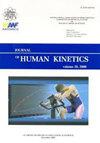职业足球比赛中技术战术和体能表现对比赛结果的影响:案例研究
IF 1.9
3区 医学
Q2 SPORT SCIENCES
引用次数: 0
摘要
比赛结果和冠军排名是球队技术、战术和体能变量的结果。本研究旨在比较一支职业足球队在不同结果的比赛中的体能和现代技术战术表现变量。本研究收集了一支法国足球乙级联赛球队在 2020/2021 和 2021/2022 赛季的 71 场足球比赛的总跑动距离、20.0 至 25.0 公里/小时和大于 25.0 公里/小时的跑动距离、≥ 3 米/秒2 和≤ -3 米-秒-2 的跑动距离以及几个现代技术战术变量(预期进球数(xG)和反对进球数(xGA)、预期进球数(xGC)和反对进球数(xGCA)以及每次防守传球数(PPDA))。这些技术战术和跑动表现变量由经过验证的视频跟踪系统(OPTA)获得,并根据比赛结果(分为 "输"(L)、"平"(D)或 "赢"(W))对每场比赛的变量值进行比较。不同的运行指标在不同的比赛结果下没有明显差异。不过,xGA(0.70 0.39 vs. 1.24 0.59;pbonferroni= 0.004)和 xGCA(5.38 2.78 vs. 10.92 6.18;pbonferroni= 0.002)在获胜和失利之间分别存在明显差异。此外,xGCA 与加速距离(r = 0.255;p = 0.032)和减速距离(r = 0.237;p = 0.047)之间存在微弱但显著的相关性。总之,虽然我们的研究发现了技术战术变量与比赛结果之间的联系,但并不能推断出因果关系。技术战术表现的提高可能会对比赛结果产生积极影响,尤其是通过降低对方的进球预期。相反,跑动表现变量与比赛结果没有关联。本文章由计算机程序翻译,如有差异,请以英文原文为准。
Impact of Technical-Tactical and Physical Performance
on the Match Outcome in Professional Soccer:
A Case Study
Match outcomes and championship rankings are the consequence of the team’s technical, tactical, and physical variables. This study aimed to compare physical and modern technical-tactical performance variables between matches with different outcomes for a professional soccer team. Total distance covered, distance covered between 20.0 and 25.0 km/h, and at > 25.0 km/h, distance covered at ≥ 3 m/s2 and at ≤ −3 m·s−2 along with several modern technical-tactical variables (expected goals in favor (xG) and against (xGA), expected goals chain in favor (xGC) and against (xGCA) and passes per defensive action (PPDA)) were collected for 71 soccer matches during the 2020/2021 and 2021/2022 seasons from a team competing in the French Ligue 2. These technical-tactical and running performance variables were obtained by a validated video tracking system (OPTA) and their values per match were compared depending on the match outcome which was categorized as “loss” (L), “draw” (D) or “win” (W). No significant differences were observed for the different running metrics depending on the match outcome. However, significant differences were observed for xGA (0.70 0.39 vs. 1.24 0.59; pbonferroni= 0.004) and xGCA (5.38 2.78 vs. 10.92 6.18; pbonferroni = 0.002) between wins and losses, respectively. Additionally, there was a weak, but significant correlation between xGCA and distance covered in acceleration (r = 0.255; p = 0.032) and deceleration (r = 0.237; p = 0.047). In conclusion, while our study found associations between technical-tactical variables and match outcomes, causality cannot be inferred. Improved technical-tactical performance may positively impact the match result, especially by the reduction of the opposing team's goal expectancy. On the contrary, running performance variables showed no associations with the match outcome.
求助全文
通过发布文献求助,成功后即可免费获取论文全文。
去求助
来源期刊

Journal of Human Kinetics
医学-运动科学
CiteScore
4.80
自引率
0.00%
发文量
83
审稿时长
3 months
期刊介绍:
The Journal of Human Kinetics is an open access interdisciplinary periodical offering the latest research in the science of human movement studies. This comprehensive professional journal features articles and research notes encompassing such topic areas as: Kinesiology, Exercise Physiology and Nutrition, Sports Training and Behavioural Sciences in Sport, but especially considering elite and competitive aspects of sport.
The journal publishes original papers, invited reviews, short communications and letters to the Editors. Manuscripts submitted to the journal must contain novel data on theoretical or experimental research or on practical applications in the field of sport sciences.
The Journal of Human Kinetics is published in March, June, September and December.
We encourage scientists from around the world to submit their papers to our periodical.
 求助内容:
求助内容: 应助结果提醒方式:
应助结果提醒方式:


